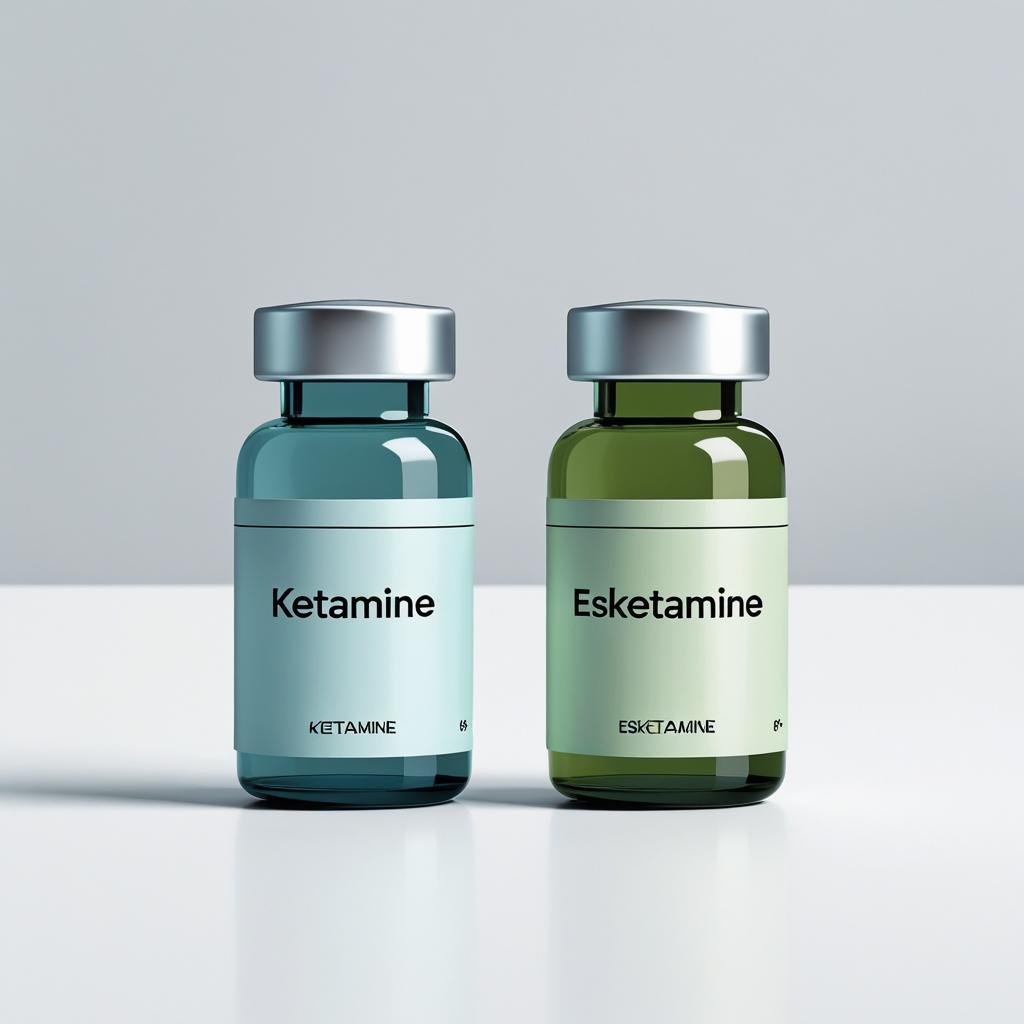You may have heard of both ketamine and esketamine being used to treat depression and other mental health conditions. But what’s the difference between the two medications?
In this article, we explain what ketamine and esketamine are, how they work, and the ways in which they’re different.
What is ketamine?
Ketamine is a dissociative anesthetic drug, which means it creates a trance-like state and can distort the perception of sights, sounds, and touch. It was first approved for human use in 1970 and is used in both surgical and veterinary medicine. In recent years, ketamine has gained attention as a promising treatment for depression, especially for those who haven’t responded to traditional antidepressants.
Ketamine works by blocking NMDA receptors in the brain. This leads to an increase in glutamate activity and triggers the release of neurotransmitters, like serotonin, which help regulate mood. Research also suggests that ketamine promotes neurogenesis, the growth of new brain cells, which may contribute to its antidepressant effects.
The form of ketamine most commonly used for depression treatment is intravenous racemic ketamine, a mixture of two mirror-image molecules, R-ketamine and S-ketamine. However, its use for depression and other mood disorders is currently considered off-label, which means it’s supported by research but not yet formally approved by the FDA. It is, however, FDA-approved for use as an anesthetic.
How is ketamine administered?
Ketamine for depression is usually administered as an intravenous (IV) infusion at subanesthetic doses – that is, amounts much lower than those used for anesthesia. A typical course includes six infusions spaced over two to three weeks, with each infusion lasting about 40 minutes. It’s also sometimes administered intramuscularly, but studies show that results are more consistent with IV infusions.
Patients might experience short-term side effects during or immediately after ketamine infusion therapy. These include dissociation, mild sedation, changes in perception, dizziness, or nausea, all of which are usually temporary and tend to resolve on their own.
We should note that, even though ketamine shows promise in a clinical setting, recreational use of the drug carries serious risk of misuse, addiction, and overdose.
What is esketamine?
Esketamine, sold under the brand name Spravato, is a derivative of ketamine. It was approved by the FDA in 2019 for the treatment of major depressive disorder with suicidal ideation (MDSI) and treatment-resistant depression (TRD) when used alongside an oral antidepressant.
This is no small feat – esketamine is the first new antidepressant mechanism to be approved in more than 30 years and it offers fast relief for patients who haven’t responded to traditional medications. Like ketamine, esketamine targets glutamate receptors in the brain to help restore connections between neurons and improve mood.
One of the main distinctions of esketamine compared to other depression treatments is how quickly it can show results – sometimes within hours compared to the weeks or months it often takes conventional antidepressants like selective serotonin reuptake inhibitors (SSRIs). Along with lithium, it’s one of the only medications proven to reduce suicidal thoughts, making it especially helpful for patients in crisis.
How is esketamine administered?
Esketamine is self-administered intranasally (via nasal spray) under the supervision of a healthcare professional in a certified treatment center. Patients typically receive treatments twice a week for the first month, followed by a maintenance phase with reduced frequency (i.e. weekly or every other week).
Because of potential side effects, like elevated blood pressure, dissociation, dizziness, nausea, or mild sedation, patients given intranasal esketamine are monitored for at least two hours after each session before they’re cleared to leave.
Differences between ketamine and esketamine
Even though ketamine and esketamine are closely related, there are many differences in how they work, how they’re used, and how accessible they are to patients. Below, we look at the key differences between the two medicines.
Chemical structure and mechanism of action
First of all, ketamine and esketamine have different chemical structures and work in different ways.
Ketamine is a racemic mixture, which means it contains two mirror-image molecules: R-ketamine and S-ketamine (i.e. esketamine). Both forms act as NMDA receptor antagonists that influence the brain’s glutamate system to improve neuroplasticity and enhance connections between brain cells.
Esketamine is the S-enantiomer of ketamine, which means it’s a purified form of one of ketamine’s two molecules. It binds to NMDA receptors more selectively and potently, which is believed to contribute to its antidepressant action. Esketamine tends to produce fewer hallucinogenic or dissociative effects compared to racemic ketamine, which some patients prefer.
Clinical uses and administration
As mentioned earlier, the two drugs are administered in different ways.
Ketamine is typically delivered intravenously, with a series of infusions given over several weeks. Intramuscular injections are also sometimes used. The dose and frequency of infusions vary depending on the patient and their response to treatment.
Esketamine (Spravato) is a self-administered nasal spray used under supervision at a certified treatment center. Patients typically receive Spravato twice a week for the first month, then less frequently during the maintenance phase.
Safety and efficacy
Ketamine and esketamine have both demonstrated efficacy in quickly reducing depression symptoms, often within hours or days. That said, ketamine has been associated with more intense side effects, including dissociation, hallucinations, and potential for abuse.
Esketamine has a more controlled dosing method, which gives it a more favorable safety profile compared to ketamine. Some patients can still experience side effects, however, including mild dissociation or sedation.
Regulation and insurance coverage
Ketamine is a controlled substance due to its potential for misuse. Its use for depression is off-label, which means it’s not FDA-approved specifically for this purpose (although its effectiveness is backed by research). As a result, insurance plans don’t usually cover ketamine treatments for depression.
Unlike ketamine, esketamine is FDA-approved for treating TRD and major depression with suicidal ideation, which means it’s eligible for insurance coverage as long as patients meet certain criteria (i.e. have tried at least two antidepressants with no success or with unpleasant side effects).
Side effects
Ketamine and Spravato can both cause side effects, although their intensity and duration can differ.
Common side effects of ketamine include:
- Dissociation
- Dizziness
- Nausea
- Elevated blood pressure
- Increased heart rate.
These side effects are usually temporary and resolve on their own.
Side effects of esketamine (Spravato) include:
- Dissociation
- Dizziness
- Increased blood pressure
- Nasal discomfort or irritation due to intranasal delivery.
Esketamine’s side effects are typically more mild than those of ketamine, and they also usually resolve on their own.
Cost and accessibility
Both ketamine and esketamine treatments can be costly, especially if you don’t have insurance coverage (as is the case with most ketamine treatments).
Ketamine is often available only in specialized clinics with trained staff, while esketamine may be more widely accessible in outpatient settings certified for Spravato administration.
Treatment considerations
Ketamine and esketamine are both typically reserved for patients with severe, treatment-resistant depression or major depression with suicidal ideation.
Unfortunately, not all patients are eligible for the treatment. Those with uncontrolled high blood pressure, a history of psychosis, liver disease, or substance use disorders may need careful evaluation before being recommended treatment.
For safety, both treatments require monitoring for vital signs during and after administration and may be combined with psychotherapy to maximize long-term benefits.
Which is more effective: ketamine or esketamine?
Now that we’ve covered the differences between the two treatments, the lingering question on your mind is likely: which is the most effective?
Well, there’s yet to be any definitive study that directly compares the effectiveness of ketamine and esketamine for depression. Because ketamine isn’t yet FDA-approved as a depression treatment, and Spravato is, a head-to-head clinical trial might not happen at any time soon.
That said, research shows that both ketamine and esketamine are effective treatment options for people with TRD. Studies on IV ketamine have shown rapid and potent antidepressant effects, with symptom relief occurring within hours and lasting for days or weeks. Esketamine has also shown rapid antidepressant effects in clinical trials, especially when used alongside an oral antidepressant.
In one 2021 meta-analysis, it was suggested that intravenous ketamine may produce faster and potentially stronger antidepressant effects compared to esketamine nasal spray. This is possibly due to it being delivered directly into the bloodstream, giving it a higher bioavailability. The same review found that ketamine intravenous infusions were often better tolerated, with fewer patients discontinuing treatment in clinical studies.
That said, esketamine has some advantages over ketamine:
- It’s FDA-approved specifically for TRD and depression with suicidal thoughts
- It offers a standardized method of dosing and delivery (nasal spray) that’s less invasive than IV infusions
- It’s more widely covered by insurance, which makes it more accessible for patients.
So even if ketamine provides faster or stronger antidepressant effects, esketamine is still a valuable and more accessible option for most people.
Explore Spravato therapy today
If you’re struggling with depressive symptoms and want to explore esketamine (Spravato) as a treatment option, our team at Psychiatry Treatment Centers is here to help. We offer this innovative, FDA-approved therapy at our treatment centers across Georgia and Los Angeles, and we’re ready to guide you through every step of the process.
Contact us today to schedule a consultation and see if this depression treatment is the right fit for you.

